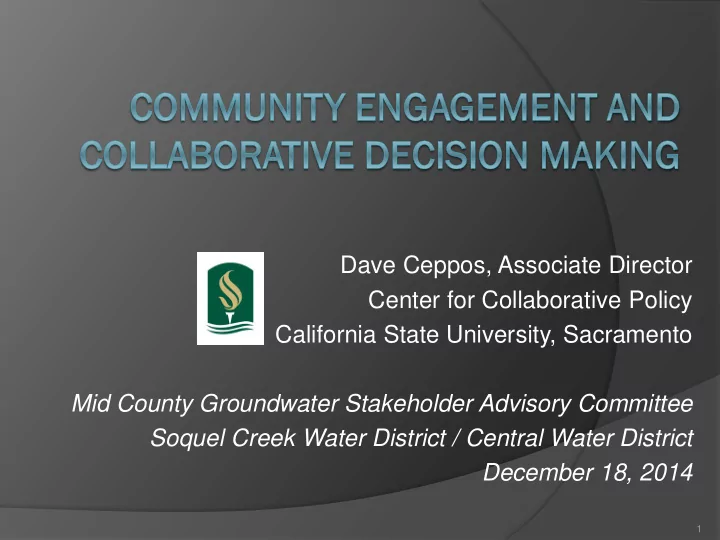

Dave Ceppos, Associate Director Center for Collaborative Policy California State University, Sacramento Mid County Groundwater Stakeholder Advisory Committee Soquel Creek Water District / Central Water District December 18, 2014 1
Presentation Agenda Introductions Definition of Terms Shifts from “Government” to “Governance” Spectrum of Public Participation Interest-Based Interaction Collaborative processes Group Discussion 2
Collaborative Definitions Issue – a matter or question in dispute, often stated as a problem Interest – a specific need or concern of a party that must be addressed for an agreement or plan to be satisfactory. Always tied to a specific motivator of need. Position – a statement or demand by a party as to how an issue should be resolved. Usually reflects what a stakeholder “wants” rather than what they need. 3
Definitions (Cont.) Multi-Interest Interaction – Engaging methods to identify and serve multiple interests Collaborative Problem Solving – Two or more parties craft a solution focusing on interest-based discussions BATNA – Best alternative to a negotiated agreement. WATNA – Worst alternative to a negotiated agreement 4
Government…to…Governance 5
Government compared to Governance Government – when public agencies have nearly sole discretion over policy decisions (e.g. water use, transportation, economic development, housing) Governance – when public agencies, societal organizations, and everyday people are collectively and actively involved shaping public policy 6
Changes: Then and Now Pre 1970s – Command & control decisions 1970 to 1980 – Foundational environmental compliance laws enacted – early examples of structured public engagement 1990s– Explosive growth of internet 2000s – Explosive growth of social media Ecology of Change – Change occurs when the change agent offers something better than the status quo 7
Context and Concepts Shift from Hierarchies to Networks 8
Shift to Governance Questioning of expert decision-making Loss of trust in elected officials and their surrogates Rising public expectations Emergence of big data and social media 9
IAP2 Spectrum 10
Collaborative Fundamentals Fundamental Principles “Enlightened Self Interest” Fundamental Commitment Create benefit for self, and neutral or better outcomes for others Fundamental Approach Consensus with Accountability 11
Collaborative Applications Stakeholder policy collaboratives Regulatory negotiations Public participation Visioning Strategic planning Internal agency issues Inter-agency issues Interpersonal issues 12
Interest-Based Interactions The most powerful interests are basic human needs: Security for self and family Economic well being A sense of belonging Recognition Control over one’s life Interests define the problem. Interests are what we need. Positions are what we want. 13
Maslow’s Hierarchy of Needs 14
Interest-Based Interactions Realize that each side has multiple interests All interests are valid Look forward not back Be specific, but flexible Be hard on the problem and soft on the people Don’t react Step to their side Don’t reject, reframe Make it easy for you to say “yes” Make it hard for others to say “no” 15
Interest-Based Interactions Don’t bargain over positions Encourage creative brainstorming Invent options for mutual gain; “expand the pie” 16
Interest-Based Interactions Move beyond demands (positions) to asking “why?” and “what do you need?” (interests) Develop linked & durable agreements Build relationships as well as agreements 17
Stages of a Structured Collaborative Process 1. Assess issues and concerns 2. Organize stakeholders and create governance 3. Educate and learn about all stakeholder interests 4. Negotiate mutually acceptable solutions 5. Implement durable and sustainable outcomes 18
Process Comparison - Examples Consult / Involve Collaborate Decision role resides at an Authority level Generally a “Y’all come party” Generally by invitation Ad hoc Representative but not exhaustive Limited capacity for consensus Focus on consensus Informational to decision-makers Advisory to decision-makers Shorter time frame Longer time frame Less expensive More expensive Less durable outcomes More durable outcomes More fractionalized More unified Reflects “government” Reflects “governance” 19
Why is This Important to You? 1. Prop 1 has only $100m for SGMA. 2. Prop 1 money won’t be available until July 2015 at the earliest. 3. Regions with no plans or inadequate plans earn negative consequences. 4. SGMA delegates authorities to regulate, limit, or suspend GW production and assess fees BUT does not delegate alteration of surface water and GW rights under common law. 20
Why is This Important to You (cont.) ? 1. Therefore….each community / basin must decide: What is the organizational “sweet spot” that will make our Sustainable Groundwater Agency successful? ○ Will we be more consultative? ○ Will we be more collaborative? ○ What is the right fit? 21
Tha Thank Y k You Dave Ceppos dceppos@ccp.csus.edu 916-445-2079 22
Recommend
More recommend